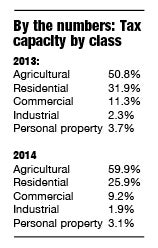Ag property owners will feel the bulk of ‘14 county tax shift
Published 10:35 am Wednesday, December 4, 2013
Agricultural property owners had a message for residential and commercial property taxpayers Tuesday night: Your time will come.
The county board held its annual Truth in Taxation meeting at 6 p.m. Tuesday in the county board room of the Mower County Government Center. While county officials are confident they could bring the maximum 2.2 percent tax levy increase to below 1 percent for 2014, that only tells part of the story.
“We’re not seeing much of a levy increase, but based on the shifting impact, we’re going to see some huge tax changes,” County Coordinator Craig Oscarson said during the meeting.
Most residential and commercial property owners, if there wasn’t a value or classification change, are likely happy with their county tax statement for 2014. That’s not the case for farmers.
“A lot of you are here because your taxes are skyrocketing while the rest of us are seeing big reductions,” Oscarson said Tuesday night.
Generally, most commercial properties are seeing a 5 to 8 percent decrease on 2014 county tax statements, and residential properties are seeing a 12 to 20 percent decrease, according to Oscarson. However, agricultural properties are seeing as much as a 100 to 200 percent increase.
“We’re probably going to average about a 100 percent increase on ag properties due to the value change,” Oscarson said during Tuesday afternoon’s board meeting.
The values are based on average sales in the county, and ag land has been selling high. But, farmers in attendance warned that might not be the case forever. Board Chairman Jerry Reinartz, who recently retired after several decades in appraisals, noted property taxes are based on value. Because ag land has the most value, it’s paying the largest piece of the pie.
In 2013, ag land accounted for about 51 percent of tax dollars, with residential accounting for about 32 percent and commercial 11 percent. In 2014, agricultural land will account for almost 60 percent of county dollars, with residential falling to about 26 percent and commercial about 9 percent.
Most of the more than a dozen people in attendance Tuesday were agricultural property owners. While residential and commercial property owners are sure to be pleased with the tax shifts, people were urging the public to be wary of taxes shifting the other way in the future.
“At some point in time, that’s going to have to shift back to the residential,” resident Larry Gerlach said.
Reinartz said he remembers ag land declining in value and residential land skyrocketing in the 1980s.
Area farmer Mike Merten told the board he sees many warning flags for the future.
“We’ve been living on some high prosperity in the ag community,” he said.
Agricultural land, he said, has been a hot commodity, drawing high sale prices, because many people jump to ag land, especially if it’s near their existing acreage.
According to Merten, the drought and ethanol industry have helped boost the grain and commodity markets in recent years, as they’ve kept a shorter supply of crops. Merten said he wouldn’t be surprised to see things change in the ag community.
“We need to look down the road and realize things aren’t always going to stay that way,” he said.
Merten was also wary of recent attacks on ethanol industry.
“I think it’s very unwarranted,” he said. “It is a good thing for our community.”
Below 1 percent?
The county approved a maximum 2014 levy increase of 2.2 percent in September. However, the finance committee and county staff worked to reduce the levy need by about $600,000. If all the changes stick, the county could approve a flat levy, according to Oscarson.
“Our main objective is to always come up with the lowest possible levy,” Reinartz said.
At 2.2 percent, the 2014 tax levy would be about $17.6 million, but county leaders could lower it to $17.3 million — a flat levy change.
However, a flat levy would not negate the tax shifts on agricultural land.
The board will need to make several decisions in the coming weeks pertaining to what reductions stick and what funding requests the board chooses to fund.
The board will use $400,000 in reserve funds for tax relief after a board proposal last year to use $1.5 million in reserves over five years for property tax relief. The county will receive about $1.2 million from state’s wind energy production tax, and Oscarson said annual operating costs will be reduced by about $175,000 now that the county moved Health and Human Services from Oak Park Mall to the Government Center.
The board will set its final 2014 budget and levy at 9:30 a.m. Dec. 17.


